The project of the main tank "Object 477"
It should be noted that the 477 Object project was not created from scratch. In the early eighties, Kharkov engineers worked on the 490 Object project, the goal of which was to create a new main tank using original layout solutions, a number of major innovations and new weapons. In 1983-84, it was decided to start a new project, which should use some of the existing developments, in addition, it was planned to introduce new ideas. The new project received the cipher "Boxer" and the factory designation "Object 477".
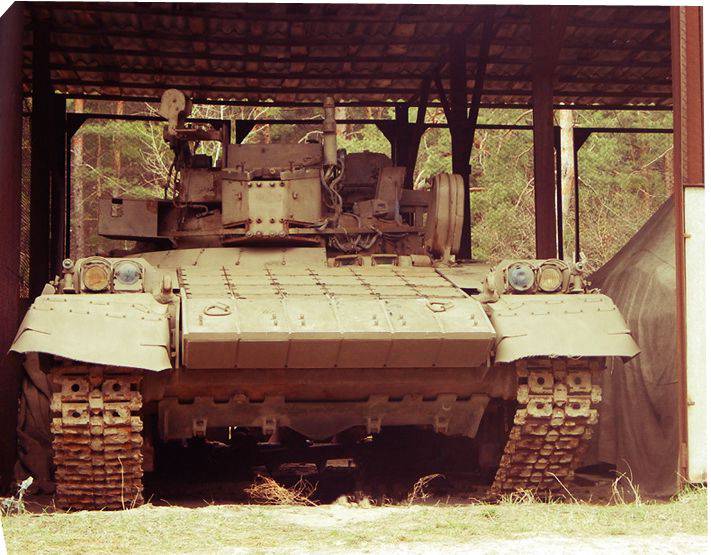
One of the latest prototypes of the tank "Object 477". The tower is turned back.
For various reasons, the amount of open information on the development of the KMDB of the eighties leaves much to be desired. The available information is fragmentary in nature and does not yet allow for a complete picture. Most of the information was not published and, apparently, still remains under the top of secrecy. In addition, there are some difficulties associated with the peculiarities of project implementation. According to reports, the Kharkov designers, in collaboration with the Research Institute of Transmash and other organizations, were working on various variants of the tank. Some sentences were studied only in theory, for checking others layouts were used. As a result, the available information may relate to different versions of the project, created in different periods, and thus complicate the construction of the overall picture.
Some problems associated with the designation of the project are also possible. In the early stages, the “477 Object” was called the “Boxer”, but in the second half of the eighties, the development work was renamed the “Hammer”. According to some information, the new name was introduced after the data on the “Boxer” fell into the hands of foreign intelligence. Changing the name of a project can also make it difficult to learn. stories.
In the framework of the projects "490" and "490" (the cipher "Rebel"), several options for arming a promising tank were considered. In the case of "Boxer" this issue was resolved quickly enough. Already in 1984, the customer and the developer decided to equip the prospective armored vehicle with an 152 caliber mm gun. Such weapons made it possible to significantly increase the firepower of the tank, providing a great advantage over the existing and prospective equipment of the conditional enemy.
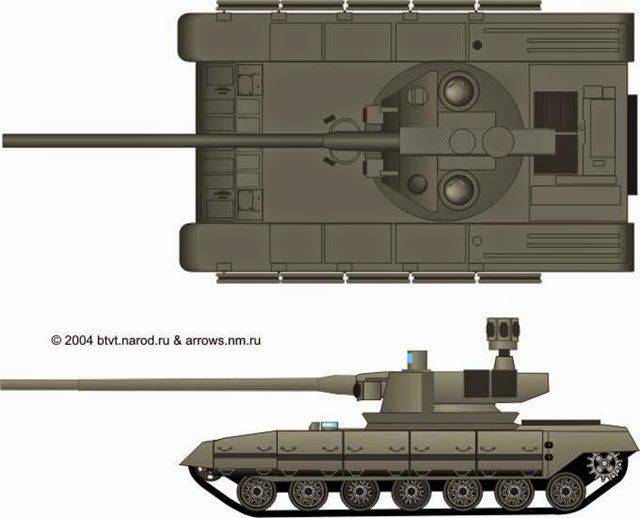
Projections of one of the variants of the Hammer tank
New weapons with larger ammunition, as well as a number of specific requirements forced the designers to closely study the various configuration options. Together with the related enterprises, the KMDB worked out several variants of the tank's architecture and in 1985, chose the best option. According to some data, in the further development of the project went only along the path approved in 85, although some innovations were being introduced all the time.
The project offered the original layout of the case and a number of other solutions related to the placement of various equipment. Thus, the workplace of the driver was placed in the front of the hull, with a shift to the left side. Next to the driver, on the starboard side, one of the fuel tanks was to be installed. Behind the driver placed the office with the commander and gunner. According to some reports, the commander and the gunner were supposed to work with a common console, with which it was proposed to manage all systems. The places of the commander and the gunner were located below the roof level, however, their layout was made in such a way as to ensure the possibility of using optical sighting devices.
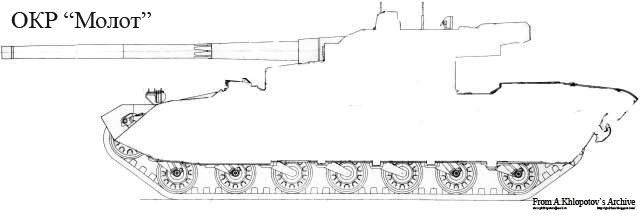
Another version of the tank
Behind the compartment with the crew's workplaces, an additional compartment was placed for storing ammunition. Feed was given to the placement of the engine and transmission. Thus, the “Boxer” / “Hammer” tank had an original layout, based on proven solutions.
Above the commander’s and gunner’s place an automated turret with a set of units should be located to ensure the use of weapons without the direct participation of the crew. For the new tank was proposed original automatic loader. Non-standard layout with the removal of all units of the fighting compartment outside the hull, as well as a large caliber of guns did not allow the use of automatic loading, based on existing solutions.
Exact information about the design of the automatic loader for the tank "Object 477" is missing. According to some information, it was supposed to equip the combat vehicle with a system with several drums. In the aft niche of the uninhabited tower, two drums were to be located, fixed on the horizontal axis. Between them, another smaller drum was planned. In the lateral large drums, various types of ammunition were to be transported, and the middle one was intended for transferring projectiles to the gun. In addition, there were mechanisms for feeding projectiles from laying the hull into the automatic loading of the turret.

The layout of the case. The original location of the crew seats is clearly visible.
For a significant increase in the firepower of the prospective tank, it was decided to use a new 152 caliber mm gun. Various sources in the context of the “Boxer” project mention LP-83, 2А73 and М-3 guns. It was planned to mount one or two twin machine guns of caliber 7,62 mm on one installation with a gun. Also could be used large-caliber anti-aircraft machine gun. Some sources mention that in the later stages of the project it was proposed to use the original anti-aircraft gun with an automatic gun caliber 23 or 30 mm. Such weapons could be used not only for hitting air targets, but also for destroying ground targets with weak defenses, for which the 152-mm gun is excessive.
Perspective tank was supposed to get a so-called. tank information management system (TIUS). Such equipment was supposed to provide communication with other combat vehicles, the processing of incoming information, weapon control and firing at the detected targets. To enhance the combat qualities of the TIUS it was proposed to include several types of optical, day and night sights.
In the early stages of the project, several power plant options were considered. The tank could get a four-or two-stroke diesel boxer or X-shaped layout. Prospects for gas turbine engines were also studied. According to some reports, the armored vehicle should have had an engine power up to 1600 hp. This made it possible to provide a sufficiently high specific power with good mobility with a combat mass at the level of 50 tons.
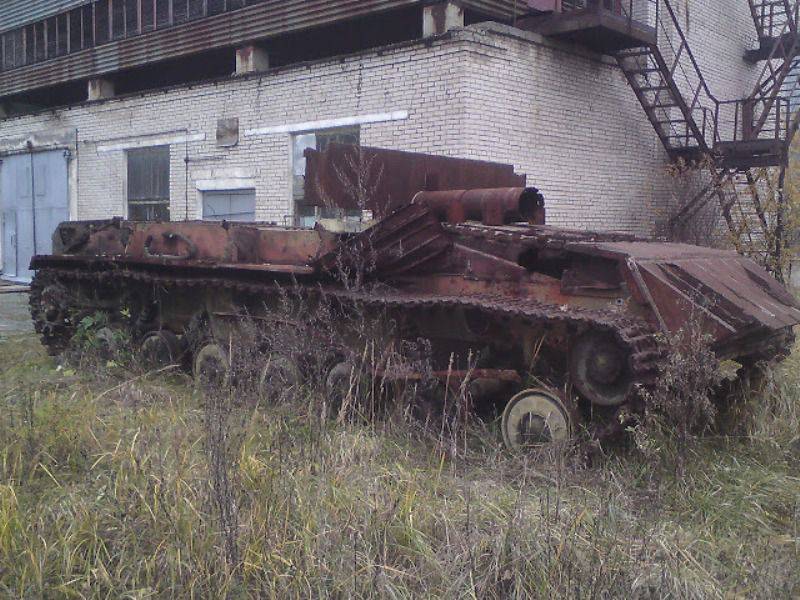
One of the running layouts of the Hammer. The remains of the machine are stored in the Institute of Technical Research
The chassis should have seven road wheels on board. A torsion bar suspension was offered with additional shock absorbers on the front and rear pairs of rollers. In front of the hull there were guide wheels, in the aft - leading wheels. It is known that during the construction of undercarriage models and prototypes, the undercarriage design was repeatedly modified. Also changed the composition of the power plant and transmission.
The tank "Object 477" was to receive a powerful reservation and a set of additional funds designed to increase the level of protection. So, in the frontal part of the body it was proposed to install a combined armored obstacle with an envelope of more than 1 m along the projectile. There is also information about the strengthening of the sides and roof of the hull. On a preserved photograph of one of the prototypes, you can see that the upper front part of the case was equipped with dynamic protection units. Similarly, it was probably planned to protect the side projection. Some sources mention the work on the choice of active protection complex, which could increase the survivability of the armored vehicle.
Design work continued until mid-decade. At the beginning of the second half of the eighties began the assembly of the first running models and prototypes of the promising tank. In the future, Kharkov specialists built more than a dozen different-purpose machines. It is known about the existence of four running layouts and eight prototypes with a different composition of equipment. All this technique was actively used in trials at various test sites. Apparently, some inspections of this technique were carried out on landfills in the territory of the RSFSR, with the result that part of the mockups and prototypes remained in Russia and are stored in various organizations.
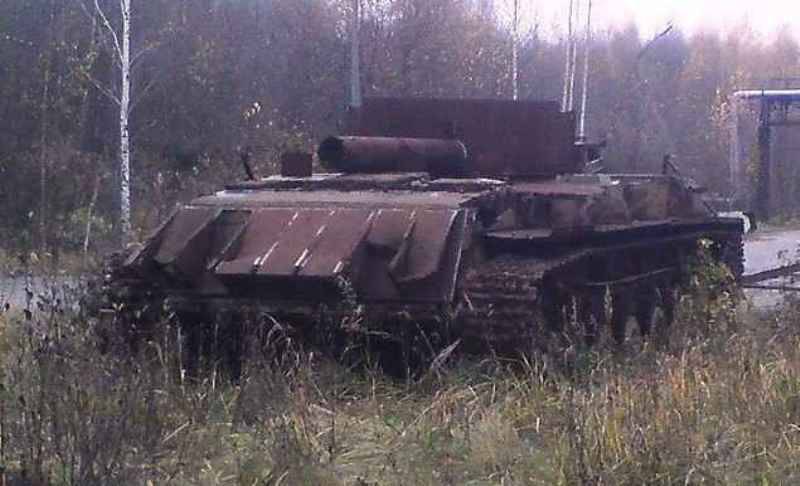
One of the running layouts of the Hammer. The remains of the machine are stored in the Institute of Technical Research
The first prototype with incomplete equipment was built in 1987 year. This machine had a full-fledged power plant and gun, but it was not equipped with an aiming complex and an automatic loader. By the time the pilot tank was built, there were no workable samples of this equipment. In particular, the automatic loader normally worked on the stand, but “refused” to perform its functions on the tank. However, this did not prevent the beginning of the test. Later, a prototype with incomplete equipment was shown to representatives of the military department and representatives of several ministries.
At the end of the eighties, the project “Object 477А” appeared, differing from the base “Hammer” with some modifications. As far as we know, the modified version of the promising tank was different for a different undercarriage design, a modified power plant and the equipment. In addition, it was proposed to use an auxiliary power unit.
How far 477 Object prototypes have progressed is unknown. There is evidence of the existence of several prototypes, which were used in various tests, but the details of their checks are missing. Nevertheless, it is known that the “Boxer” / “Hammer” project ended in failure. Despite the introduction of several new ideas and the solution of a number of important issues, the project had no prospects in the existing situation.
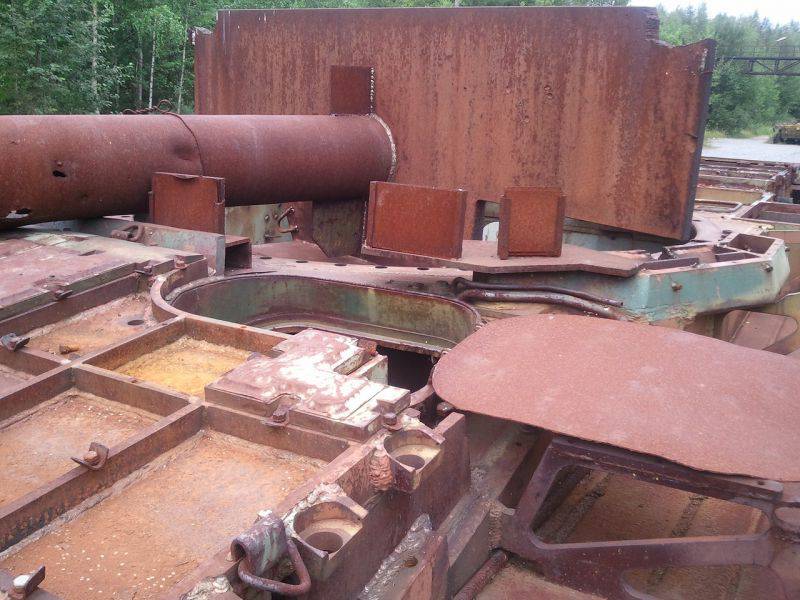
One of the running layouts of the Hammer. The remains of the machine are stored in the Institute of Technical Research
The prospective main tank "Object 477" was developed from the mid-eighties, and the tests started at the end of the decade. By this time, serious economic and political problems had begun in the country, which, among other things, had hit the defense industry. Further development of the project was not excluded, but the possibility of starting the full-fledged construction of new tanks was completely absent.
After the collapse of the Soviet Union, the KMDB specialists attempted to continue the development of a promising project, but all efforts did not lead to the expected results. There is information about the creation of updated projects and even the construction of several prototypes. However, the former Soviet republics did not experience the best period in their history, and the economic situation did not allow them to engage in projects of promising armored vehicles.
Over the past years, the possibility of continuing work on the Hammer or projects that have become its development has been repeatedly mentioned. However, an independent Ukraine is not able to implement such plans. Enterprises from all over the USSR took part in the creation of new armored vehicles, which made it possible to solve all the arising tasks and produce modern combat vehicles. The collapse of the Soviet Union led to a break in industrial relations, which seriously limited the possibilities of Ukrainian enterprises. Recent developments of a political and economic nature completely deprive the country of the possibility of developing modern tanks. Apparently, all the bold and unusual projects of the KMDF, developed since the beginning of the eighties, will remain on paper.
On the materials of the sites:
http://btvt.narod.ru/
http://alternathistory.org.ua/
http://russianarms.ru/
http://bmpd.livejournal.com/
http://andrei-bt.livejournal.com/
http://gurkhan.blogspot.hu/
Information